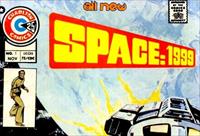Comics: Charlton Comics
Compiled by Martin Willey
In the early 1930s, John Santangelo began his publishing career with a magazines containing the lyrics of public songs. Unfortunately he didn't clear the copyrights, so in 1934 he served a year in jail. On leaving jail, he and his attorney, Ed Levy, started new publications, this time legally by clearing copyrights with the song publishers. In 1942 they launched Hit Parader magazine, one of the first popular music titles. The company bought a second hand printing press, previously used for printing cereal boxes. The press was expensive to stop and restart, so they kept it running continuously, day and night, with a huge range of different publications. From 1945 they began to produce comics, repackaging content from syndicates. In 1955 they began producing comics in-house instead of outsourcing, with their own staff of artists. In 1968 they acquired the licenses from King Features (Popeye, Blondie) and Hanna Barbera (The Flintstones, Yogi Bear).
Uniquely among US comic companies, Charlton owned the complete publishing line including editorial, printing and distribution. The comic titles were low budget compared to bigger competitors such as DC and Marvel. Artist pay was low, but Charlton had a reputation of fostering new talent and giving more creative freedom.
In the 1970s, the comics were managed by editor George Wildman. Creative control was by writer Nicola Cuti, with prolific writer Joe Gill and in-house artists including Joe Staton and a young John Byrne. The biggest name artist was Steve Ditko, who through the 1950s, 60s and 70s alternated between Charlton, DC and Marvel (where he created his best known characters, Spiderman and Dr Strange); while he had worked for Charlton in the early 1970s, in 1975 he had just moved to DC.
At the start of the 1970s, the American comics industry was led by DC and Marvel and their superhero titles. Younger children's comics went into sharp decline as children switched to television cartoons. Comic book readers were getting older, with teenagers and college students the biggest audience. The standard comic book was printed with the four-colour system, with black and white confined to low budget and niche titles.
With older comic-book readers, the publishers and artists were anxious to attempt darker, more socially relevant subjects and more experimental art styles. Marvel and DC began new titles based on horror, supernatural and sword and sorcery, previously the preserve of smaller publishers like Warren. Superhero comics themselves became grittier, in what would later become known as the "bronze age of comics". Marvel and DC introduced a new larger "magazine" format, with black and white pages, deliberately targeting "mature" readers and avoiding the Comics Code and its strict morality rules.
In the 1970s, Charlton was publishing around 40 bimonthly comics, mostly for younger children. They had numerous other non-comic magazines, from crosswords to martial arts, but they expanded their comics into the magazine format cautiously, with just three titles in 1975, all based on TV series: The Six Million Dollar Man, Emergency! and Space: 1999. For each, they also produced a standard four-colour comic for younger audiences.
Both titles had text stories or articles, as postal costs were reduced if a certain number of pages were not comic art. Charlton's existing relationship with Hanna Barbera, who were handling the merchandising for ITC in the US, helped them land the deal. Cuti explained:
"The way it worked was we had gotten the license from Hanna-Barbera - they were the go-betweens with ITC. We got the license through HB, because we had been doing HB comics.... There was a feeling of 'high hopes' for the entire Charlton line. We knew that competing with the Big Two, DC and Marvel Comics, was a lesson in futility. We were a niche company, filling in the gap left by the Biggies. Our comics were horror, Western, war, mystery, romance, big-foot [cartoons]. We filled in the genres other comic-book companies ignored. Yes, we did some work in superheroes - Blue Beetle, The Question, Captain Atom, E-Man, and Yang - but mostly we wanted to give the public a choice, in case their taste wasn't for superheroes."

The Comics Code Authority (logo top right) verified every comic adhered to moral principles, including that government figures should always be respected, criminals must always be punished, violence should not be "excessive". Established in 1954, the code was revised several times in the 1970s, but increasingly comic publishers were catering to teenagers and adult readers. Over the next few decades all the major comic publishers dropped the CCA, initially for selected titles in the 1970s, and eventually for all comics by the 1990s.
By the end of 1976 and through 1977 many of the titles ended or became erratic. Most of the artists went to work at DC or Marvel, and their relationship with Continuity Associates, their other source of art, broke down. The company finally ended in 1985.